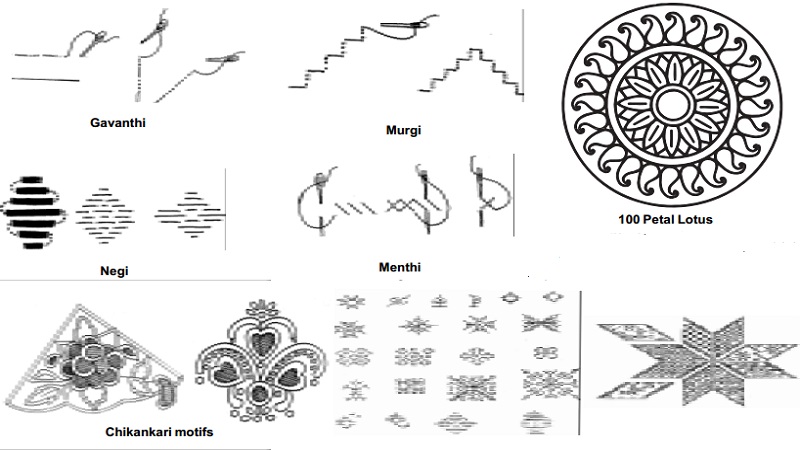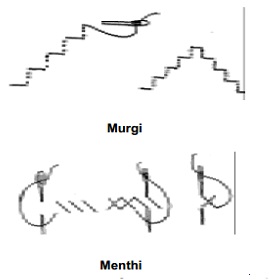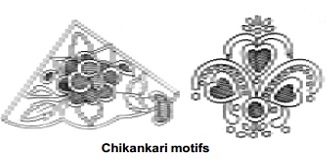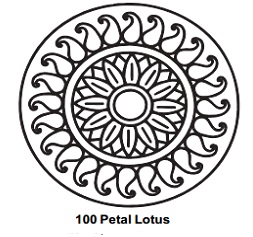Chapter: 11th 12th std standard Textiles And Dress Designing Cloth stitch Higher secondary school College practical steps methods Notes
Traditional Embroidery

TRADITIONAL EMBROIDERY:
Indians are world famous for their magnificient workmanship and produce the most beautiful handspun and handwoven textiles, yet preserved and exhibited in many of the known Indian as well as Western museums. Many visitors, poets, travellers, tourists appreciated the textile and embroidery of India to the core.
It is observed from the ancient time, even the primitive man did decorate himself through bodily decoration and ornamenting his attire. Primitive man worshipped 'Nature' and it was one of the sources of inspiration from which he picked up motifs of floral, bird and aimal kingdom available geographically.
Each State in the country is unique by itself as far as textiles and its variegated designs are concerened. The traditional embroidery of each state has the influence of not only the foreign countries like Persia, China, Iran etc., but also the neighbouring state too. Though, this being the fact, the Statewise embroideries are unique and not a duplication of others. This is mainly because of the difference in the mode of people, the availability of indigenously manufactured textile material, ground fabric, influence of eocology, custom, festival, deity, occupation, skill, likes and flare for various motifs, technique of stitchery, threads and so on. However, it can be said that the local people are totally responsible and are the pioneeers of their unique embroidery.
Traditional embroideries of some of the States are Kasuti of Karnataka Kantha of Bengal, Chikankari of Lucknow, Kashida of Kashmir, Chamba rumal of Himachal Pradesh, Pulkari of Punjab. The detailed explanation of the Kasuti, Kantha and Chikankarai are given below.
1. Kasuti of Karnataka:
Kasuti is a world famous embroidery of Karnataka. 'Kai' means hand, and 'suti' means cotton thread. Hence Kasuti means hand work made of cotton thread.
History:
The women expressed their artistic urge by embroidering delicate piece of colourful art, the Kasuti. This art was passed from person to person and generation to generation. During leisure time the grandmothers used to teach Kasuti to their grandchildren, daughter-in-law and neighbours.
In oldern days it was a custom that the bride had to possess a black silk sari called 'chandra kali sari' with Kasuti work on it. As a matter of fact traditionally this embroidery is done on saris and blouses. The blouse (choli) on which Kasuti with match color motifs and borders worn with this sari is known as 'Khan'. The border of sari will be with Negi and Murgi stitches.
Thread:
Silk thread is used in olden days. Now instead of silk yarns, mercerised cotton threads with guaranteed color fastness are used. Two to four strands are used for fine and coarse work respectively. This may vary according to the type of material motif and stitch employed.
Motifs:
The motifs used in Kasuti are taken from mythological stories, architectural motifs like gopuras, shiva linga, nandi palanquine etc. are used. Apart from these various types of creepers, foliages, flowers, animals and birds are used.
Stitches:
Stitches are always worked in vertical, horizontal and diagonal manner. The common four types of stitches used in Kasuti are Gavanti, murgi, negi and menthi.
Speciality of Kasuti stitches:
The designs are never traced.
Embroidery starts without knitting threads, but with a tiny back stitch.
Types of stitches:
a. Gavanthi:
This is a simple more common stitch derived from the Kannada word-Gantu means 'knot'. It is a double running stitch, in which the first running stitch is filled by the second running stitch on the same line. The second one worked exactly opposite to the first one.
Gavanthi may be worked in horizontal, vertical or diagonal directions.

b. Murgi:
This is a zigzag runnings stitch which appears like staircase. It is same as Gavanti stitch but works in a stepwise manner. The work in both Gavanti and Murgi stitches is neat and tidy, where the design appears same on right and wrong side of the material. However, the stitches should be of uniform size. Designs are produced by grouping the tiny designs on regular intervals and sequences.

c. Negi:
This is another stitch in Kasuti. Negi in Kannada means 'to weave' i.e. Negi design has an overall effect of a woven design. Negi is nothing but ordinary running or darning stitch. It is worked in long and short straight lines or floats and therefore the design does not appear identical on either sides of the cloth.
d. Menthi:
This stitch is an ordinary cross stitch. Menthi in Kannada means 'Fenugreek Seed'. This cross stitch usually appears heavy as it is used for filling purpose. This stitch requires more length of thread than the other three stitches. Similar to Negi, even this stitch does not give same appearance on either sides of the cloth. It can be seen in Ikat sarees.

2. Chikankari of Lucknow:
Chikan work is otherwise called as 'shadow work', white work or white embroidery.
The charm of this type of embroidery is very attractive and delicate style enhanced through the use of single color with simplicity miniature pattern and unbelievable eveness. This embroidery is basically down with white thread muslin background. Hence the name 'white embroidery'. On narrow strips of cloth, this embroidery gives fine and delicate lacy effect.
Material:
Chikankari though done on the white muslin background now is done on fine cotton material like voile, two x two, cambray, mulmul, organdie, chiffon, georgettes, nets and other similar sheer fabrics.
Motifs:
The motifs used are mostly flowers, foliages, creepers and birds.
Stitches:
Stitches like satin, back, stem, buttonhole and herringbone stitches are used.
a. Bukhia:
'Bukhia' is nothing but satin stitch, which is done on the wrong side of the material and the design is delicately outlined with tiny running stitches from the right side. This sort of embroidery gives an opaque effect. The effect of fine muslin background produces a shadow appearance.
b. Simplified Bukhia:
Herringbone is used in the place of sation. The stitches that appear on the back of the cloth is of herringbone style. It gives a shadow effect on the right side. This is easier and simpler than Bukhia.
c. Murri:
'Murri' is a knotted style of chikankari, worked in the centre of flowers, giving an embossed effect. It is nothing but French knot, which resemble the rice grain in shape.
d. Tepchi:
Tepchi is a simple running (darning) stitch, used to fill the straight or curved lines in the floral design. It is mainly used to give the outlines for the design. It is a flat style.
e. Button hole stitch:
This is used to cover small floral motifs. Closed blanket stitch is usually used for this.
f. Khatawa:
This is used in the place of Bukhia which is a minute applique work.
g. Jali Work:
'Jali work' gives an effect of open mesh or net like appearance. Sometimes it looks like drawn thread work or lace like. This effect is produced by pushing apart the warp and weft yarns with the help of needle, forming into tiny holes and are later tightened to give the cloth firmness and appearance of a net.
Uses of chikan work:
Chikan work was done on sari borders, pallu with tiny buttas in the body of the sari, blouses, kurtas, cuffs, collars, jubbas, handkerchiefs, caps, table mats, cushions, curtains and other household linen.

3. The Kantha of Bengal:
The traditional folk art of Bengal is famous as Kantha, which means 'Patched Cloth' and 'quilting'. The Dacca muslin saris of gray, black or white coloured are used for thin embroidering. The old discarded cotton saris or dhotis are piled up on the top of each other quilted and embroidered.
The size of thickness of Kantha varied according to its type. The layers of pieces are sewn together by simple darning stitch in white thread, drawn from the old sari borders.
The design is first traced and the filling is done by coloured thread, taken from the coloured borders of saris. Lotus is the most common and important motif widely used in Kantha.

Method of stitching:
Usually satin with tacking is used for this kind of embroidery. Tacking is done to attach layers of fabric together. Work tacking stitch from centre to edge or vice versa.
Motif:
100 petal lotus is the most common motifs used for kantha. Other than this scenes from day to day life, folk stories, mythological stories are used.
Speciality:
In original kantha both the sides will be identical.
Items with Kantha embroidery:
There are different kinds of kanthas named according to its utility. There are seven types of kanthas used as wrappers in winter, for book, valuables, mirrors, combs, wallets, pillows and bedspreads.
a. Bayton:
Bayton, a three feet square piece serves as a wrap for books and other similar valuables. It has a central motif, usually the lotus with hundred petals called 'Satadala Padma'. The core has Satadala Padma with two or three borders on the sides. The other motifs commonly seen are water pots conch shells, kalkas, trees, foliages, flowers, birds, elephants, chariot, human figures etc.
b. Arshilata:
Arshilata is used as cover or wrap for mirror, comb and other such toilet articles. It is a narrow rectangular piece of 6' x 12' length. It has a wide border and the central motif is taken from the scenes of Krishna leela. The lotus, trees, creepers, spirals, inverted triangles, zig-zag lines, scrolls are also some of the commonly used motifs.
c. Durjani:
It is a square piece Kantha of 16' x 16' covers the wallet, has a central lotus motif with an elaborated border. The three corners of this piece are drawn together inward to make the tips to touch at the centre and are sewn together like an envelop. It will have another flap to which a string, tussle or a decorated thread is either stitched or mechanically fixed, which can be wound and tied up when rolled. The other motifs used are various types of foliages, snakes and other objects from the natural surroundings.
d. Lep Kantha:
It is relatively a thick quilted wrap of 6� feet x 4� feet by more number of sari layers, placed on top of each other to provide warmth during winter season. Simple geometrical designs are worked with running stitch using coloured threads. The entire lep piece is been given a way rippled appearance by working simple embroideries.
e. Oar Kantha:
Oar (ooar) kantha serves as a pillow cover. It is a rectangular piece whose size is about 2' by 1�'. Usually simple designs like trees, foliages creepers, birds or a liner design with longitudinal border constitutes the ground base and decorative border is stitched around its four sides.
f. Rumal:
Rumal is nothing but a hand kerchief and is the smallest among all the kanthas. A square piece having a size about one square foot. Lotus is the core and other motifs embroidered around it. Sometimes plant and animal motifs are also embroidered but invariably has a well decorated border.
Related Topics